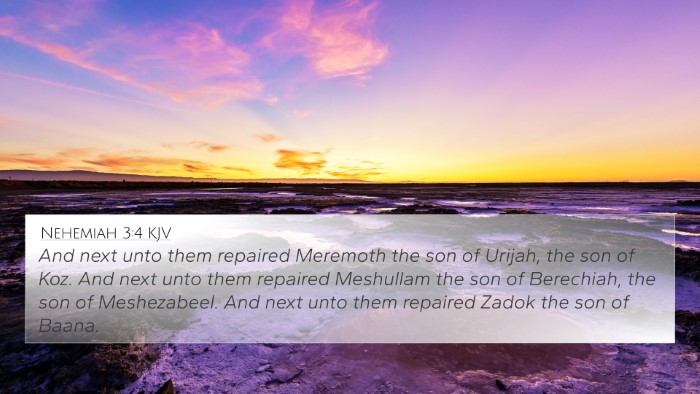Understanding Nehemiah 10:5
Verse: "And we sealed unto it the princes, the Levites, and the priests."
Nehemiah 10:5 presents a moment of commitment by the leaders of Israel, outlining their determination to uphold the covenant with God following the rebuilding of Jerusalem. This verse is a part of a larger narrative in which the people restore their identity and faithfulness to God.
Contextual Meaning
The book of Nehemiah recounts the return of the Jewish exiles from Babylon and the rebuilding of Jerusalem's walls. In this context, chapter 10 describes a formal renewal of the covenant between God and His people. The leaders, including princes, Levites, and priests, officially seal their commitment, emphasizing the importance of their roles in leading the community in faithfulness.
Commentary Insights
- Matthew Henry: Henry emphasizes the significance of the leaders taking an active role in affirming God's covenant. The act of sealing shows not only their dedication but also sets a precedent for the people to follow, ensuring that their agreement with God is both serious and binding.
- Albert Barnes: Barnes points out that this sealing was not merely a formality but a recognition of the responsibilities that come with spiritual leadership. The leaders' vows to uphold the covenant reflect their intention to guide the Israelites in observing God's laws.
- Adam Clarke: Clarke considers the socio-political implications of this sealing, arguing that it reinforced the unity among the leaders and the community. Their collective commitment signifies a commitment to God that seeks to prevent future lapses in faithfulness.
Bible Verse Cross-References
This verse connects well with several other scripture passages that highlight themes of covenant, commitment, and leadership:
- Deuteronomy 29:10-15: The gathering of leaders and people to reaffirm God's covenant.
- Ezra 10:5: The binding commitment of Ezra leading the Israelites to swear an oath.
- Jeremiah 31:31: The promise of a New Covenant that speaks to the everlasting nature of God's commitment.
- Luke 22:20: The reference to the New Covenant established through Christ's blood.
- Hebrews 8:8-12: Commentary on the New Covenant's establishment and its significance.
- 1 Peter 2:9: A declaration of God's chosen people, emphasizing their calling and responsibilities.
- Malachi 2:5-6: Illustrating the role of priests in keeping the covenant and teaching righteousness.
Comparative Bible Verse Analysis
Understanding Nehemiah 10:5 in relation to these other verses can deepen one’s insight into the necessity of leadership and collective commitment to God throughout the Bible.
The thematic links between these scriptures revolve around the concept of community, leadership, and faithfulness in covenant relationships. The historical context of Nehemiah's time parallels the spiritual leadership emphasized in the New Testament, where Jesus establishes a New Covenant through His death and resurrection.
Inter-Biblical Dialogue
The connections between Nehemiah 10:5 and other scriptures highlight God's enduring relationship with His people and leadership's role in guiding that relationship. The Old Testament lays the groundwork for the New Testament’s revelations about Christ and His church.
Tools for Bible Cross-Referencing
To further explore the depths of Nehemiah 10:5 and its corresponding themes, various tools can assist in Bible cross-referencing:
- Bible Concordance: Helps locate verses based on keywords for deeper thematic studies.
- Bible Cross-Reference Guide: Provides a structured approach to finding related verses.
- Bible Chain References: Offers a method of linking scripture that relates to similar themes.
Conclusion
Nehemiah 10:5 serves as a pivotal moment reflecting the leaders' promise to uphold God's covenant, indicating both commitment and accountability. This passage, in conjunction with related scriptures, emphasizes the enduring nature of God’s promise and the role of faithful leadership across biblical history.






